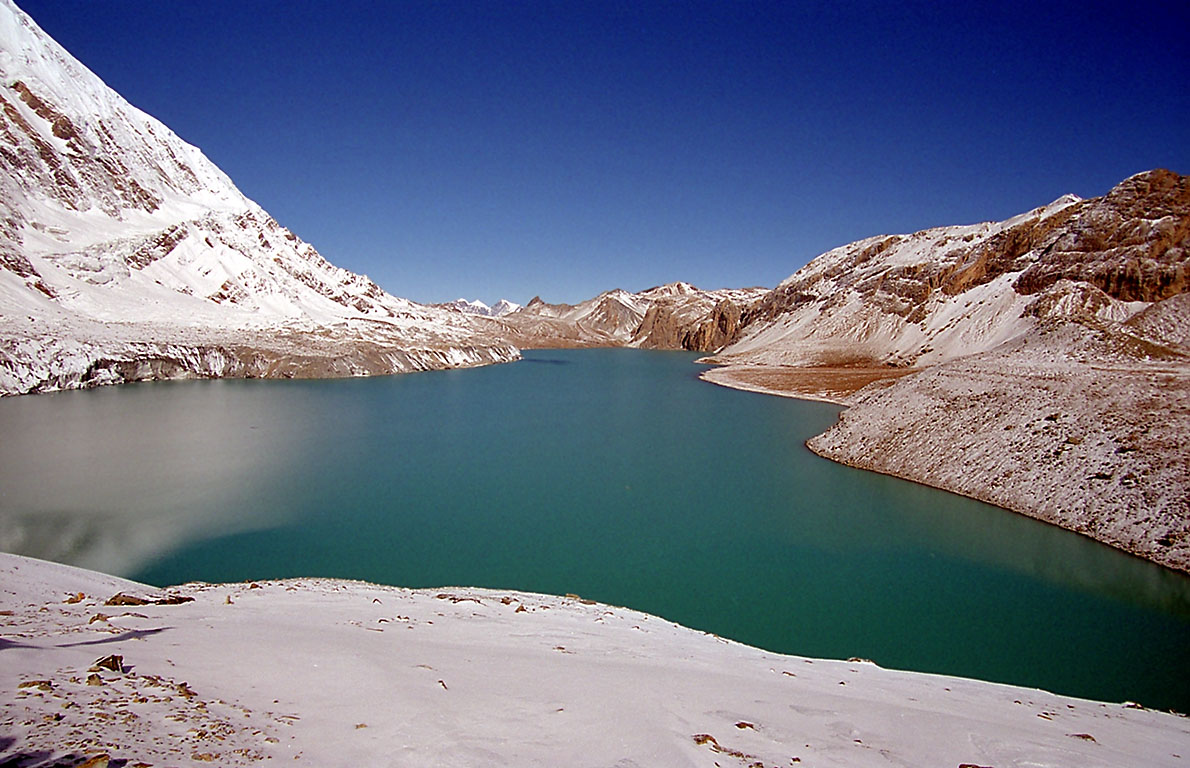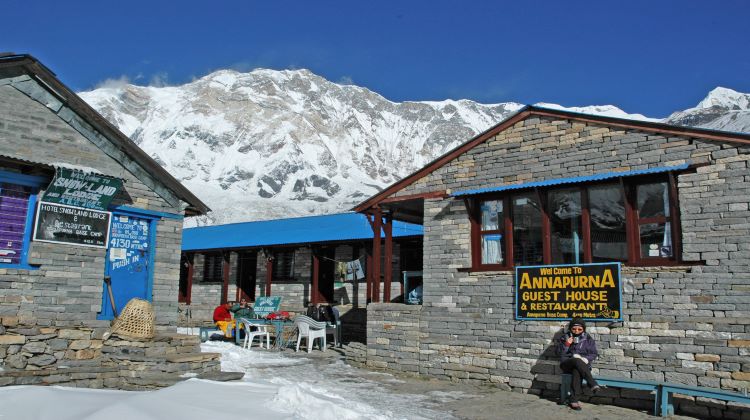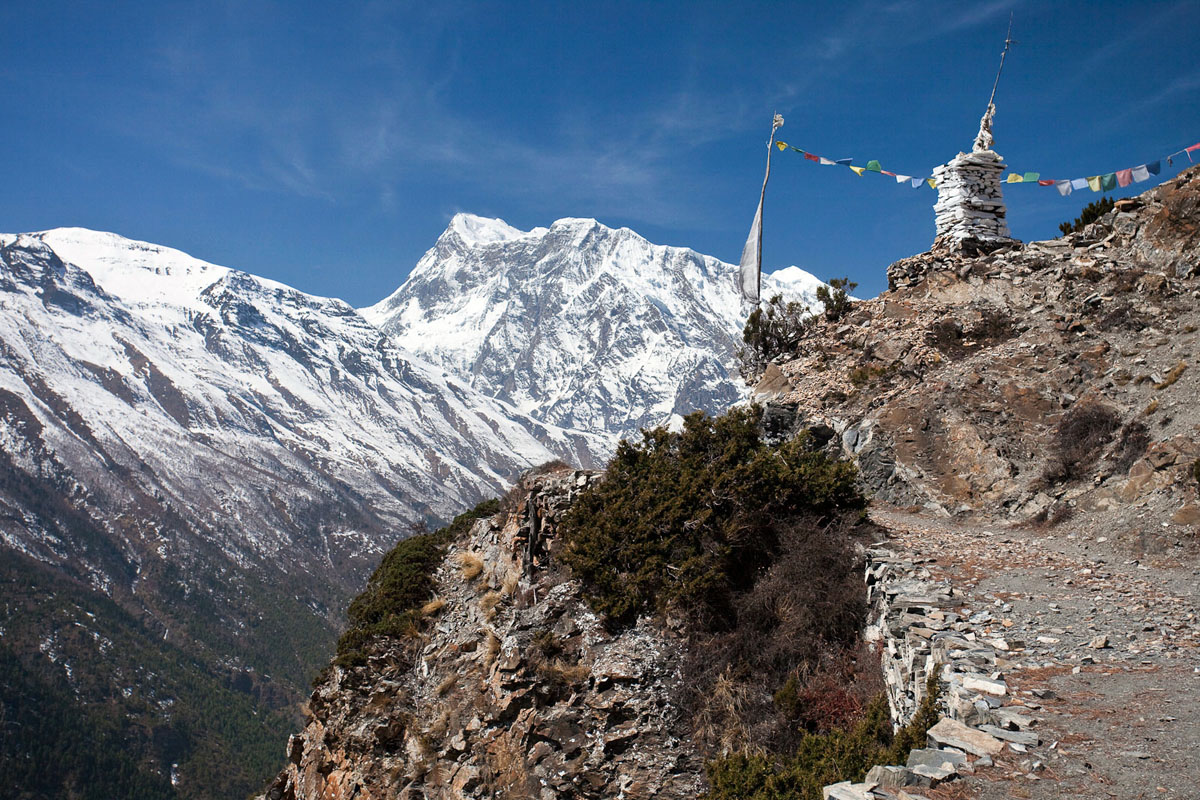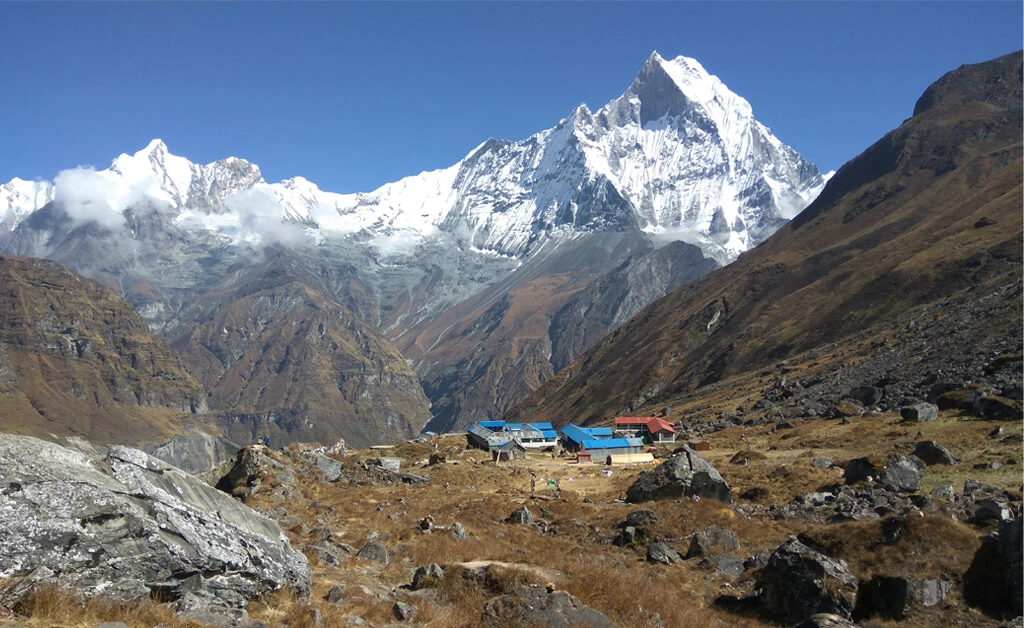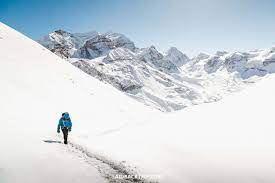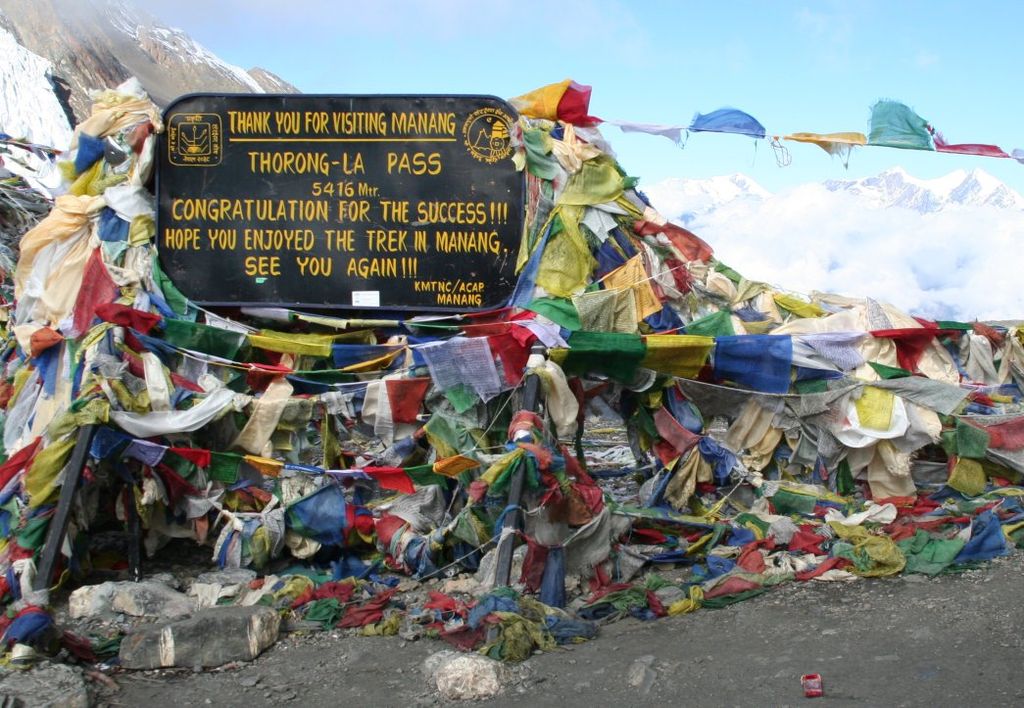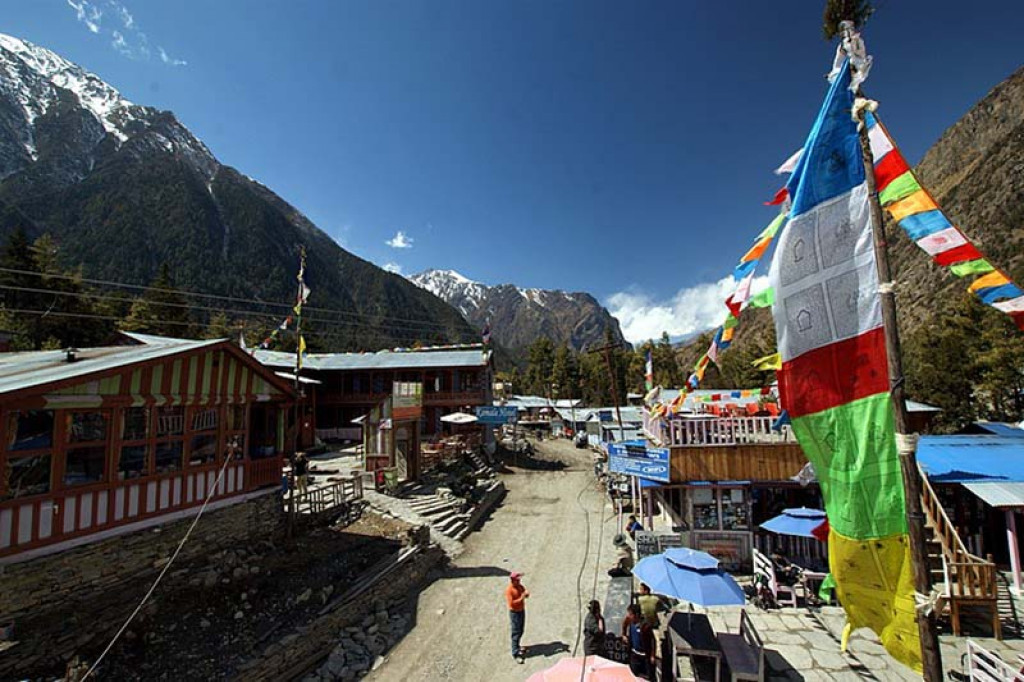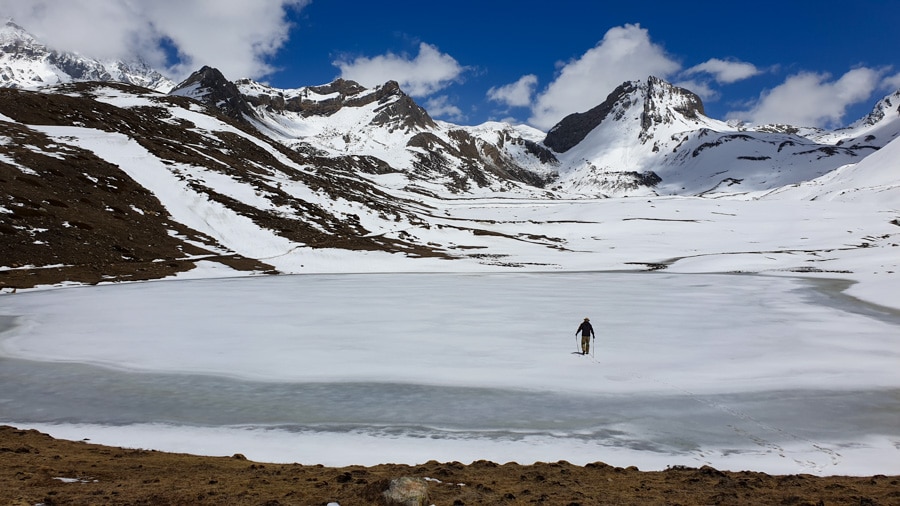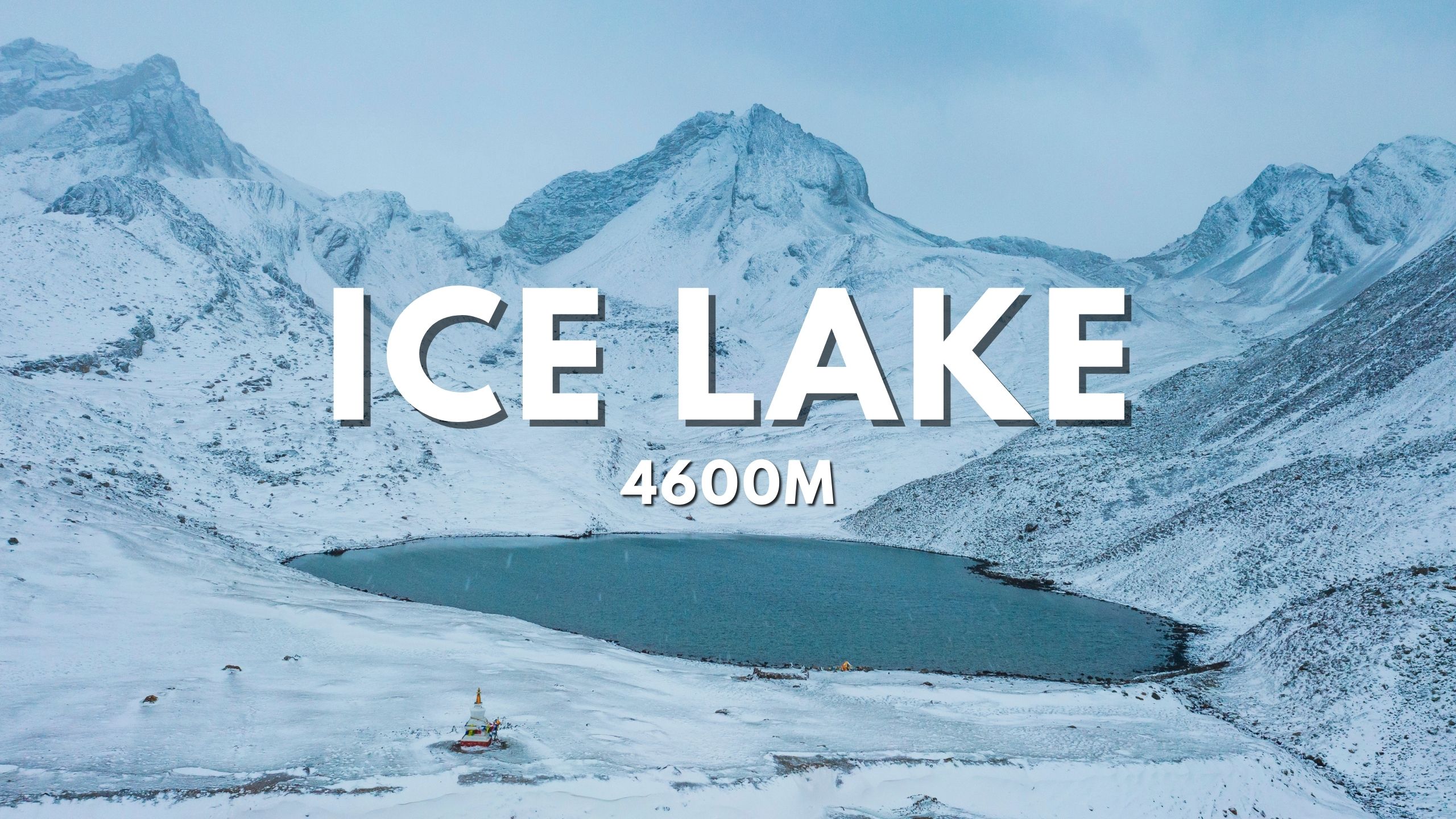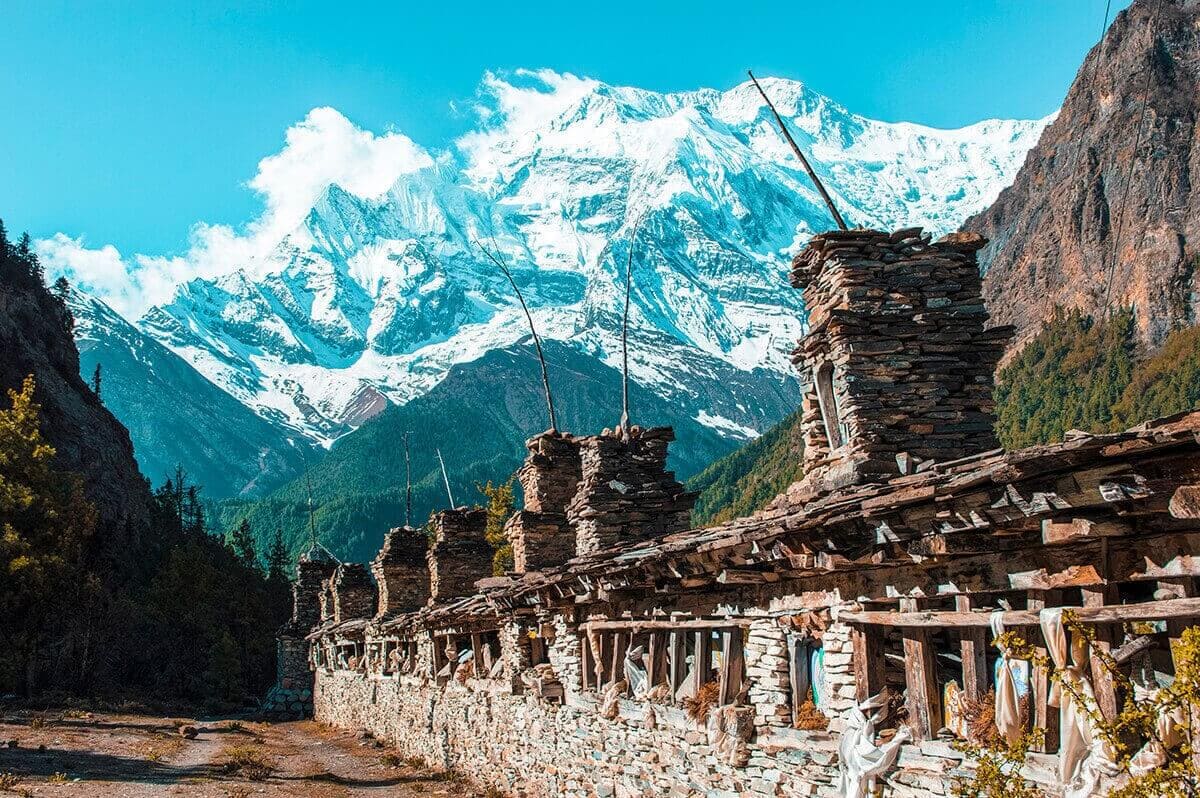Abc Via Annapurna circuit
Trip Overview
Overview
The ABC via Annapurna Circuit is a captivating journey through the Annapurna region of Nepal, offering a remarkable blend of natural beauty, cultural encounters, and challenging adventure. Spanning 160 to 230 kilometers, this iconic trek also takes around 10 to 21 days to complete, depending on the chosen route and pace. The trek's starting point is often Besisahar, and the trail gradually ascends through lush forests, terraced fields, and charming villages inhabited by diverse ethnic communities. As trekkers advance, they are also rewarded with awe-inspiring vistas of snow-capped peaks, including the mighty Annapurna I, Dhaulagiri, and Machhapuchhre (Fishtail), among others. The highlight of the journey is conquering the formidable Thorong La Pass at 5,416 meters, a challenging ascent that demands physical fitness and proper acclimatization. The sense of accomplishment and the breathtaking panoramic views from the pass make it all worthwhile. Throughout the trek, teahouses and guesthouses dot the trail, providing basic accommodation and nourishing local meals. These cozy rest stops also serve as meeting points for fellow adventurers from around the globe, fostering a sense of camaraderie and shared experiences.Experiencing the Annapurna Circuit Trek: Best Seasons, Permits, and Cultural Encounters
The best times to embark on the Annapurna Circuit Trek are spring (March to May) and autumn (September to November). During these seasons, the weather remains stable, and clear skies offer uninterrupted views of the majestic mountains. Obtaining the Annapurna Conservation Area Permit (ACAP) and the Trekkers' Information Management System (TIMS) card is mandatory before setting out on the trek. Many trekkers opt to hire local guides and porters to enhance their experience, as they provide invaluable insights into the region's culture, history, and natural features. As trekkers traverse this picturesque route, they encounter the distinct traditions and hospitality of the Gurung, Thakali, and Manangba communities, among others. Their colorful festivals, monasteries, and ancient traditions enrich the trekking experience, offering a glimpse into the cultural tapestry of the Himalayas.Conclusion and Summary
While the ABC via Annapurna Circuit Trek is a once-in-a-lifetime adventure, trekkers should be mindful of altitude sickness, stay hydrated, and allow time for acclimatization to ensure a safe and enjoyable journey. With its mesmerizing landscapes, cultural encounters, and physical challenges, the Annapurna Circuit Trek remains an unparalleled adventure for all nature enthusiasts and trekking aficionados.Trip Highlight
- Spectacular views of the Annapurna mountain range, including Annapurna I (8,091m) and Machhapuchhre (6,993m).
- Trekking through diverse landscapes, from lush forests and terraced fields to high-altitude desert and alpine meadows.
- Crossing the challenging Thorong La Pass (5,416m) on the Annapurna Circuit.
- Visiting traditional Gurung and Thakali villages, experiencing local culture, and interacting with friendly locals.
- Exploring the serene Annapurna Base Camp (4,130m) surrounded by towering peaks.
- Witnessing breathtaking sunrise views over the Himalayas from Poon Hill (3,210m).
- Enjoying natural hot springs in Tatopani and a relaxing soak in Jhinu Danda.
- Immersing in the tranquility of the Annapurna Sanctuary and feeling the spiritual ambiance of Muktinath.
- Capturing memorable moments amidst stunning Himalayan scenery and diverse flora and fauna.
Itinerary
We take a bus for the five-hour drive to the end of the road, either at Besi Sahar or a bit farther depending on the road conditions, where we stay the overnight. At Bhulbhule.
After early breakfast we hit the trail. We have about three hours of hot but pleasant walking; we are trekking in the typical Nepali middle hills now, and the scenery is gentle, muted. After crossing a suspension bridge at Bhulbhule, the trail passes a cascading waterfall, and as we traverse the rice terraces, the views of Manaslu are magnificent. Following a gentle incline we come to the village of Ngadi with its picturesque shops,From here we climb, steep and hot, to Bahundanda. Bahundanda literally means “hill of the Brahmins” and it is the most northerly Brahmin settlement in the Marsyangdi Valley, situated high up on a ridge.
A steep trail descends from Bahundanda through green rice terraces before crossing a stream at the bottom of a small waterfall. It then climbs again and traverses the hillside high above the river before reaching the village of Hani Gaon. Ahead, the Marsyangdi valley forms a steep V-shape, and we follow the winding mountain path down through Syange and along the river for some distance. The trail then climbs steeply and the path is cut into the sheer cliff-face some 200-300m above the riverbed. Eventually we descend to the atmospheric village of Jagat, situated on a shelf which juts into the precipitous Marsyangdi valley, where we spend the night at a Tibetan-run lodge.
We awake to a morning climb, head steeply up through a forest to a wonderful teahouse just before Chamje and marked by a magnificent waterfall on the opposite bank. Chamje is an atmospheric village of traditional-style teahouses, often packed with saddled local horses. After descending to the river and crossing a suspension bridge, we begin a steep climb to some small teahouses at Sattale. After chai, we continue on an undulating path above the river, climb the switch-backing path to the top of the hill, and are treated to the sight of Tal below us on a wide plain by the river. Though it is enclosed by cliffs, the level area is reassuring after the slightly harrowing mountain paths on which we have just traveled. Beyond Tal and the checkpost, the valley narrows and the path becomes high and winding, and in several areas is actually hewn from the rock. Beyond the small village of Karte, there is a bit more exposed trail walking before the path drops again to the river. We cross a suspension bridge, and climb the short distance to the stone kani marking the entrance to Dharapani
Continuing to climb through forests of pine and oak, we pass through Danagyu before coming to a thundering waterfall, where we turn left and head up the high trail to Koto. After an hour of lovely, open forests, we reach a clearing at the top of the trail and a charming Tibetan teahouse where we will stop for a break. Pausing for breath, we can look back for views of Manaslu. An hour away is the wonderful Gurung village of Timang, where the villagers might be harvesting their crops of buckwheat or stuffing local sausages. Heading back down to the village of Koto Qupar, our base for the trek up to Nar Phu, we can look straight up at nearby Annapurna II – a stunning sight convincing us that we are deep in the Himalayan mountains! Many of the villagers are the from Nar Phu valley; this is the gateway to their region. Less than an hour brings us to Chame, the local administrative center of Manang, and a large village packed with small shops and tea-houses, an army post and a large school. We bed down here for the evening.
It’s a beautiful walk from Chame to Pisang, through woods with some small ascents, and wonderful views of the peaks soaring above us. It’s just a five hour day, so we’ll have the afternoon in Pisang to explore the village, with it’s Tibetan mani stones and gompa, perhaps taking a walk up to Upper Pisang for amazing views of Annapurna II and Annapurna III. Overnight.
6 hours walk past a series of unique and colorful chortens to Manang, at 3500m, a village of 500 or so flat-roofed houses, the headquarters for the region, and an interesting village packed with trekkers, bakeries and lodges. Manang is dominated by high peaks – Annapurna III and Gangapurna tower over it, and a dramatic icefall sits just across the river. There is an old gompa on the edge of town, many local teahouses, and some atmospheric, winding streets in the village leading out toward the Thorung La. Finally, guest houses, showers, cold beers! There is a 3 o’clock lecture on altitude by the Himalayan Rescue Association for anyone interested. Overnight.
today is our acclimatization day, with lots of options; a long day-hike to the Ice Lake, a visit to the ‘Hundred Ruppee Lama’ at the cave gompa above Manang, a two-hour hike to Milarepa’s cave across the river from Braga, the HRA talk, or a tour of Manang’s many bakeries. A hike up 300 meters or so for acclimatization is recommended, but nothing too strenuous is required. The guest house is wonderful, a sunny and warm place to gaze at the peaks in the afternoon. Overnight
It’s not a long day today, but we gain some altitude, so should take it slowly. En route, we will undoubtedly be passed along the trail by galloping Manangi horses, saddled with wonderful (and expensive) Tibetan wool saddle blankets, and their jubilant Manangi riders, bells jingling as they gallop by. We climb past Tengi and Gunsang to Yak Kharka. Overnight.
An easy two or three hour walk up to the Thorung La Base Camp Hotel at Thorung Phedi, and after an early lunch, another hour or so to hike up to the lodge at High Camp, where we will stay the night, getting to bed early for our early morning start the next day; pass day! If anyone is having problems with altitude, we have the option of staying at Thorung Phedi Base Camp, where we had lunch, a nice spot to spend the afternoon with its glass windows. Overnight.
Up early for the three or four hour walk to the top of the Thorung La at 5400m, where we are treated with spectacular views over Mustang and the surrounding peaks. The descent is almost as demanding as the ascent to the top of the pass, so a cup of chai and a snack at the local tea house at Chabarbu, at the bottom of the descent, is a required stop. And on to lower Mustang, which we have actually reached just after the pass, and the serene templeMuktinath is an important pilgrimage site for Buddhists and Hindus situated in a tranquil grove of trees, and contains a wall of 108 waterspouts in the shape of cows heads spouting sacred water, the Jwala Mai temple with a perpetual spouting flame and the pagoda-styled Vishnu Mandir, all of which make up the auspicious combination of earth, fire and water. We stay just five minutes down the trail from Muktinath at Ranipauwa complex of Muktinath.
We have a nice morning’s walk down the Kali Gandaki riverbed, looking for saligrams along the way, to Jomsom, the administrative center for the region. The Kali Gandaki valley gets incredibly windy in the early afternoon, so important to arrive before noon; we’ll have lunch in Jomsom, and there is a bank if anyone needs to change money. Here there is an airport with regular flights to Pokhara, a bank, post office, hospital and few hotels. Permits are checked here. Overnight at Muktinath
We have a nice morning’s walk down the Kali Gandaki riverbed, looking for saligrams along the way, to Jomsom, the administrative center for the region. The Kali Gandaki valley gets incredibly windy in the early afternoon, so important to arrive before noon; we’ll have lunch in Jomsom, and there is a bank if anyone needs to change money. Then another few hours to Marpha along the same riverbed. Marpha is a white-washed village of cobbled streets, small shops, horses and donkeys, a recently rebuilt gompa and caves above the village, and a wonderful place to stop for the evening. Overnight.
We continue descending the Kali Gandaki Gorge to Tukuche, a delightful village with a large gompa. Beyond Tukuche we walk along the west bank of the Kali Gandaki towards Larjung. Here, as in many of the villages in this area, narrow alleyways and tunnels connect houses with enclosed courtyards, providing protection against the winds blowing up the valley. We make our way through pine, juniper and cypress forests to Kalopani, enjoying fine views of Annapurna I and Fang. Ghasa, our next desination, lies an hour beyond Kalopani. Overnight.
Another long day, but well worth the effort to get to Tatopani, where the double hot springs are situated scenically next to the riverbed, well-deserved massages are offered by the hot springs, the bakeries are heaven, oranges and lemons fall from the fruit trees and the monkeys play across the river. Overnight.
Get ready for some more hills! Today’s walk is a hot one, and quite strenuous as we branch off after an hour of walking from Tatopani from the trail heading to Beni, and take the Ghorepani trail, starting straight up hill.
Those who want can hike up Poon Hill for a 360 degree Himalayan panorama; one of the best view point in Nepal. You can spot whole annapurna range with Dhaulagiri. After breakfast, we have a half day’s walk to Tadapani, where we’ll be treated to spectacular views of Machapuchare. Watch for monkeys on the way up! Overnight.
Moving down from Tadapani the path bestows good sights of the Modi valley. The trail then begins the long way up above the west shore of the Modi Khola. We get ahead of the village of Chhomrong which is located at the base of Himal Chuli. From Chhomrong the way moves down until Chhomrong Khola then we have a slow climb and reach Sinuwa Hill.
After move down from Chomrong then we have a challenging ascend to Sinuwa we keep on trekking up through the forests going across the small settlement of Bamboo and Doban till we ultimately reach Himalayan Hotel.
We start from Machhapuchhre Base Camp and we make a temperate climb through a river to abruptly above the mountain side. Walking from Deurali, we will arrive at a point where we will be encircled by huge snow-covered peaks. Moving ahead to Machhapuchhre Base Camp we reach at a set where the views of Mt. Annapurna South, Annapurna I, Himchuli, Annapurna III and, definitely, the Machhapuchhre itself enthralls us. Overnight in Machhapuchhre Base Camp at guesthouse.
From Machhapuchhre base camp (3900m.), we continue to Annapurna base camp. The area is encircled by the peaks and is recognized as Annapurna Sanctuary. This set gives you an impressive view of huge peaks including Annapurna I, Barah Shikhar, Annapurna South and many other giant peaks. We today walk for around 2 to 3 hours.
This is it! Our big day kicks off with an initial, relatively easy trek from Lobuche to Gorekshep. The subsequent, straight trail to Everest Base Camp is harder, involving rocky dunes and moraine, formed accumulation of unconsolidated glacial debris. On the way to our destination, we’ll approach the famed Khumbu Glacier and icefall, located on the slopes of Everest. At the Base Camp, our goal, you’ll have the chance (during the spring climbing season) to meet climbers attempting to scale the mountain’s summit. Break out your cameras for unbelievable views of breathtaking beauty. As the afternoon sun starts to wane, we’ll head back to Gorekshep for some much-needed rest and relaxation after a grueling and busy day.
We move early morning and witness the wonderful sunrise over the peaks from Annapurna Base Camp. Then, we move down from Annapurna Base Camp via Deurali, Dovan and eventually reach Bamboo. We gradually, walk down to reach the valley where we again see the waterfalls that pours down from a high above. Tonight, we stay in Bamboo at guesthouse.
Leaving Dovan we have a vertical way up to the Kuldi Ghar then Sinuwa, following the stone steps that take us to Lower Chhomrong. After that, we ascend on the stony steps that lead us to Upper Chhomrong. From Chhomrong, we walk down to Jhinu Danda. Here, we will take bath at natural warm water spring. Overnight at guest house in Jhinu Dada.
Today, we move down again to the next river and after going across the suspension bridge we have to go up for about another one and half hour before we get to the most stunning village in the Annapurna region entitled Ghandrung (1950m.), a large prosperous Gurung village.
We leave Ghandrung and move towards New Bridge and proceed to Kyumi village. We arrive at Syauli bazaar and then go up to Birethanti. Walking further for around an hour from Birethanti we will reach Naya Pul. From Naya Pul, we retrace our steps back taking a locally available vehicle and arrive at Pokhara. Then after, we take a flight with same picturesque view and reach Kathmandu from Pokhara. After you reach Kathmandu, optionally, we can relax or walk to visit different sights of Kathmandu. In the evening, we will have a farewell dinner together. Overnight at hotel in Kathmandu.
Passing all the way through the striking countryside early in the morning and travelling for 7 hours we return back to Kathmandu. On arrival at Kathmandu you will be transferred to the hotel and rest of the day rest or explore the surrounding areas and overnight at hotel.
Today, our airport representative will drop you to the airport and then you will depart from Nepal.
Important note on itinerary: Although Ever effort will be made to follow the schedule above, this itinerary is subject to change due to weather conditions, route conditions, conditions of trekkers, conditions of staff and other factors which is beyond our control.
Enjoy Trek!
Departures & Availability
The set departure dates listed are specially quoted and specified for group joining option. Let us know if the set departure dates are not suitable for you- another dates which are suitable for you can certainly be added by us.
Check Available Dates
| Start Date | Price | Availability |
|---|
All trip prices are per person based on double occupancy, are subject to change without notice and do not include airfare. All prices and fares are quoted in U.S. dollars.
Price include
1. Airport Pick-up and Drop Off,
2. Licensed and trained trekking guides,
3. potters for carrying goods and supplies,
4. Meal on full board (breakfast, lunch, dinner, tea & coffee) basis during the trek
5. 3 Nights Accommodation in the 3/4/5 Star Hotel in Kathmandu with B & B. (Bed
& Breakfast)
6. All accommodation during the trek.
7. All meals and hot beverages during the trek.
8. Transportation to and from the trail head.
9. All necessary documents and permits for trekking (where applicable)
10. National Park/Conservation Area entry Permit, Insurance, and equipment for the staffs.
11. Coordination of quick Rescue service (Costs covered by your Insurance Plan)
12. Trekking staffs wages etc.
13. 1 hr. trekker massage after your trek.
14. Welcome and Farewell dinner in a Nepali Cultural Dance restaurant in Kathmandu.
15. Flight Ticket Kathmandu to Lukla to Kathmandu
16. Trekking Staff Insurance of $10,000 Per Person.
17. Trekking Map, T-shirt, and Trekking certificate.
18. Exclusive of Medical Kit Bag
19. All Government and Local Taxes
20. International Flight ticket re-confirmation.
21. Meals will be Start when your Trek starts.
Price Excludes
1. International Airfares,
2. Travel/Trekking Insurance,
3. Excess baggage charges More than 16kg and handbag more than 5 kg in
domestic flights.
4. Visa fees.
5. Airport Departure Taxes.
6. Drinks (Cold and Alcoholic) Rescue charge.
7. Tips for The staffs.
8. Expenses of Personnel nature and Permit and Liaison officer fee (where Applicable.
9. Meals during stay in the Kathmandu and Pokhara.
10. Domestic Ticket Etc.
11. Extra Hotel in Kathmandu and Pokhara.
Gears And Equipment
Trip Information
Here’s some essential trip information for the Annapurna Circuit with Annapurna Base Camp Trek:
Duration: The duration of the trek typically ranges from 20 to 22 days, including arrival and departure days.
Best Time to Go: The best time to trek the Annapurna Circuit with Annapurna Base Camp is during the pre-monsoon (March to May) and post-monsoon (September to November) seasons when the weather is generally clear, and the views are stunning.
Difficulty: The trek is considered moderate to challenging, with high-altitude passes, steep ascents and descents, and long days of trekking. Previous trekking experience and a good level of fitness are recommended.
Permits: Trekkers need to obtain the Annapurna Conservation Area Permit (ACAP) and the Trekkers’ Information Management System (TIMS) card before starting the trek. These permits can be obtained in Kathmandu or Pokhara.
Accommodation: Accommodation during the trek is primarily in teahouses or lodges along the trail. These accommodations provide basic amenities such as beds, blankets, and meals. In larger villages, there may be more options for accommodation.
Altitude Sickness: Since the trek involves ascending to high altitudes, it’s essential to acclimatize properly and be aware of the symptoms of altitude sickness. Trekking guides are trained to recognize and manage altitude-related issues.
Guides and Porters: Hiring a local trekking guide and porter is recommended for safety, navigation, and support during the trek. They also provide valuable insights into the local culture and surroundings.
Packing List: A comprehensive packing list includes essential trekking gear such as sturdy hiking boots, warm clothing layers, rain gear, sleeping bag, sunscreen, and water purification tablets, among other items.
Insurance: Trekking insurance that covers high-altitude trekking and emergency evacuation is essential for this trek.
Medical Considerations: Trekkers should consult with a healthcare professional before the trek, especially if they have any pre-existing medical conditions. Bringing a basic first aid kit and any necessary medications is also important.
Responsible Trekking: Trekkers are encouraged to practice responsible trekking by respecting local customs, minimizing waste, and supporting local communities by purchasing goods and services locally.
Emergency Contacts: Familiarize yourself with emergency contacts, including local authorities, trekking agencies, and medical facilities along the trekking route.
By considering these trip details and adequately preparing for the trek, you can have a safe and memorable experience exploring the breathtaking Annapurna region of Nepal.
ABC via Annapurna Circuit Trek Route Map

FAQS
Lorem Ipsum is simply dummy text of the printing and typesetting industry. Lorem Ipsum has been the industry’s standard dummy text ever since the 1500s, when an unknown printer took a galley of type and scrambled it to make a type specimen book. It has survived not only five centuries, but also the leap into electronic typesetting, remaining essentially unchanged. It was popularised in the 1960s with the release of Letraset sheets containing Lorem Ipsum passages, and more recently with desktop publishing software like Aldus PageMaker including versions of Lorem Ipsum.
Lorem Ipsum is simply dummy text of the printing and typesetting industry. Lorem Ipsum has been the industry’s standard dummy text ever since the 1500s, when an unknown printer took a galley of type and scrambled it to make a type specimen book. It has survived not only five centuries, but also the leap into electronic typesetting, remaining essentially unchanged. It was popularised in the 1960s with the release of Letraset sheets containing Lorem Ipsum passages, and more recently with desktop publishing software like Aldus PageMaker including versions of Lorem Ipsum.
Traveler Reviews
These full and frank reviews are from travelers who have traveled with Ace the Himalaya previously. The reviews and experiences shown here are from reputable travel websites like TripAdvisor, Google, Facebook, and Trust Pilot, etc.

